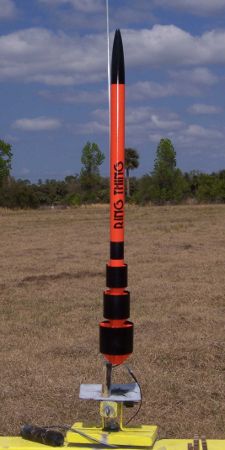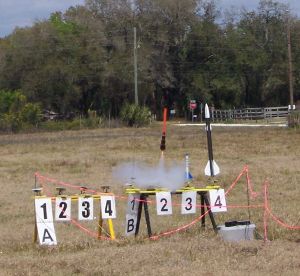Scratch Ring Thing Original Design / Scratch Built
Scratch - Ring Thing {Scratch}
Contributed by Hans "Chris" Michielssen
| Manufacturer: | Scratch |
I rarely build or fly two-stage rockets. My best success with staging incorporated the old Centuri Pass-Port design. The holes in the coupler gave the booster engine that extra split second to ignite the upper stage.
Construction: The initial pencil designs lead me to a descending ring profile. Three rings held in place by four small fins under each ring. The model almost looks as if it were a three stager. The highest painted band gives the impression of a smaller ring and a fourth stage. I went to my scrap tubes and tried many until I found the three sizes that would give the visual of "conical" descending rings. The model was built around a ST-10 airframe. The booster is 3" long, the sustainer body tube is 18". The ring on the booster is a 2-1/8" length of BT-80. The lowest ring on the sustainer is a 1-7/8" length of BT-70. The second higher sustainer ring is 1-5/8" of ST-16. And the final (black painted) ring is 1-3/8" wide. The fins were cut from 1/16" balsa and covered with 20lb copy paper. I did this for two reasons. The first is strength. Secondly, it would be impossible to fill the balsa after the rings were glued in place. The balsa grain direction is opposite of normal construction. The grain follows the trailing edges of all the fins. The trailing edges are outside the rings. I wanted to give a little more protection for those exposed edges. Wrapping paper over the top of the rounded leading edge gave more than enough frontal rigidity. All fins were cut wide, which allowed me to sand the outside edges to slip-fit the rings in place. I didn't glue the rings in place until after spray painting the main body and fins. I sprayed the rings separately then glued them over the fins. This gave me a no-mask paint job and clean color separations. The only masking was to paint the wide black band on the body tube. On the engine mounts, I followed the old Centuri plans for their Arcon-Hi model. The booster engine block is at the rear of the booster. The sustainer block is normal, at the top of the upper engine tube. The only changes I made from the Centuri plan was to cut the sustainer engine tube 1/8" shorter than the original 3" length. This way the engine would be extended 1/8" out the back of the tubing. The engines are friction fit with masking tape. After a flight, I wanted a little bit of the casing sticking out to remove it out with pliers. Centuri style staging doesn't use clear tape to hold the engines together. Both stages are held together by two couplers. Simply friction fit the engines in place then slide the stages together. [Click on the following link to download a PDF of the rocket.] Flight: Later that day, I tried again with the same engines. This time it was stable and had a straight boost with good staging and recovery. I thought it would be stable, but I hadn't used RockSim yet. There was a large ring area and plenty of fins. I thought the body tube length would be adequate. I went home and weighed the clay. I added the equivalent weight in washers to the screw eye. It required 0.4 oz (or five WW-7 washers from Semroc) of nose weight to be stable. Like every "different" design, sometimes extra nose weight is required. The third flight took place on May 2, 2009 at the Orlando ROCK launch. I used B6-0/B6-6 engines. While the model was stable with a B6-0/A8-5 combination, it was not stable with a B6-0/B6-6. At the sustainer ignition, it looped. It was in the air at ejection, no damage. Summary: CONs: Even with all the fins and tubing, the model required nose weight to be stable. It was stable for the second flight after adding nose weight. It was not stable for the third and final flight. Brief:
Brief:
This model was designed and flown for the 2009 EMRR Challenge.
I didn't want to go with a standard two-stage design, fins above fins. I decided on a ring stabilized two stager.
The first flight was on March 7 with a B6-0/A8-5 engine combination. The first stage boost was good, but when the sustainer ignited it was unstable. Recovery was safe. I added a hefty blob of clay weight around the large screw eye and nose cone base.
PROs: I was happy with the finished look of the model. Visually, the descending rings and painted black band give the impression of a conical stabilized rocket. While the model is only two-stage, it looks more like a three stager. New designs can present construction and stabilization issues, but if you glean a few new lessons in the process it's all worthwhile.
Sponsored Ads
 |
 |











